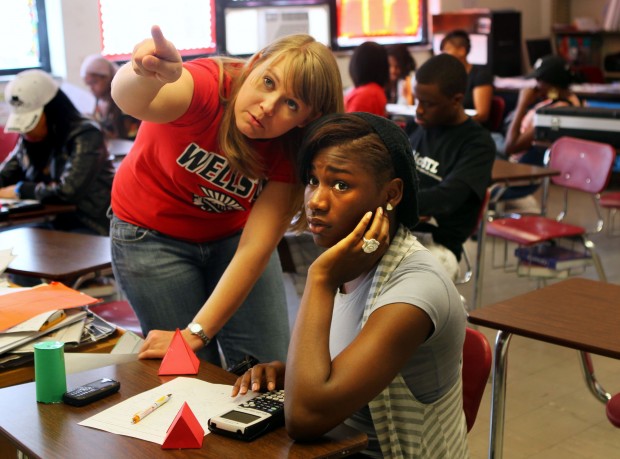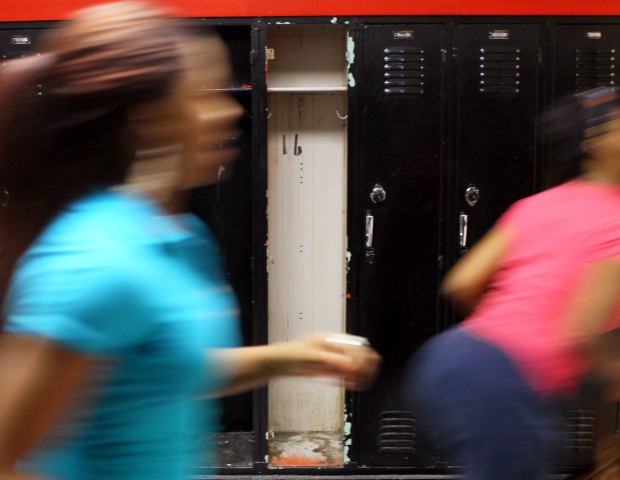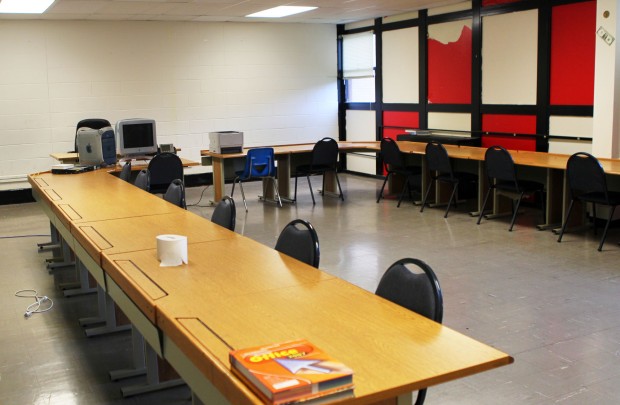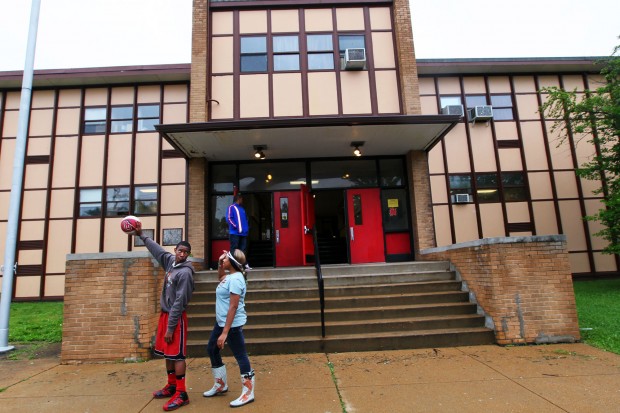Wellston • Look all you want at the brown water stains on the computer lab's ceiling.
Shake your head at the torn periodic table and the cracked glass cabinets in the science lab now nearly empty of beakers and test tubes.
Go ahead and glare at the trash and dust collecting like tumbleweeds under the gym bleachers and the patches of dirt and weeds in the brick planters along the school's front stairway.
You won't see the same school that the students at Eskridge High School see.
Outsiders — and even some teachers — have told students they will be better off going to school someplace else. State education officials have decided that dissolving the school district and sending its students to neighboring Normandy schools will be best.
But to the students, Eskridge is their high school, and Wellston, one of the poorest urban communities in the state, is their town.
People are also reading…
- Fake property deed crime on rise, warn officials in St. Charles, St. Louis counties
- At least 1 arrested after large fights break out in Tower Grove Park in St. Louis, police say
- Man killed in Florissant house explosion was making fireworks, police say
- Dylan Holloway on being injured for the playoffs, his rehab and a potential extension in St. Louis
- AquaSculpt Reviews (Ice Water Hack) Best Diet Pills for Weight Loss in 2025
"I want to graduate from Wellston," said freshman Jamie Davis, 15, as she guided a reporter through her school, slated to close June 1.
Beside her, junior Tyrice Jenkins, 16, nodded and agreed. He had been weighing his own situation carefully. He has plans to go to college and spent his summers at a Washington University college prep program. Tyrice knows his chances of getting into college will be better in a school district with more resources — but still, this is his school.
"I want to graduate from Wellston," he said.
Last night, to cheers and camera flashes, the last Wellston graduates — 30 altogether — marched across the stage at Harris-Stowe State University.
"Wellston may not be the best school ever, but it's our school," said senior Carmen Harris said as fellow grads cheered. "This school has held our community together. We will never forget where we came from."
Their satiny gowns were the school colors: red for girls, black for boys. Those colors can be proudly found in homes and the handful of businesses that remain in Wellston.
Last year, the state's Department of Elementary and Secondary Education called it quits on the financially strapped district of about 550 students. Despite recent upticks in test scores, the district has underperformed academically for years.
Superintendent Charles Brown, who was appointed by the state to turn the district around, said when he started his job six years ago, only one student went on to college. Now, nearly all the seniors who graduate are accepted into college. The number of students testing proficiently has inched up from just 1 percent six years ago to about 16 percent. But that wasn't enough, Brown said.
"One of the things we need to do is to take a look not at where they are now, but how far they've come," Brown said.
District finances were just as troubled. With nearly all of the big business and industry gone in Wellston and a vast majority of its homes owned by the Wellston Housing Authority, Brown said the district lacked the tax base to fix its crumbling buildings and outdated classrooms.
Wellston first started educating students in the late 1890s and was once one of the region's wealthiest suburban areas, thanks to a bustling commercial strip fed by a major streetcar terminus. Its center was the home to the regal Mikado and Wellston movie houses and a thriving shopping district.
But then the buses came in the 1960s, and the streetcars went away. Malls were built farther north and west, and much of the white population went with them on the interstates to new subdivisions. All the students now in the Wellston School District are African-American.
Since news in December of the high school's closure, the school has let much of its maintenance and some programs go. A third floor exit sign is shattered. Nobody has bothered to take down a poster in the science lab vandalized by graffiti. And the basement shop class never opened its doors this year.
This week, librarian Jonathan Sanders began packing up a collection of books he has toiled to rebuild in the last three years. He'll be moving on to the Hazelwood district next year. Many of his colleagues have yet to find jobs in this tight economy.
Near the front entrance, the once-glittering glass trophy cases sit empty. Wellston may be small and poor, but its Trojan basketball teams have always rocked their competitors.
Fearing students might take the trophies as mementos, administrators made the early decision to pack them away. Sanders said Normandy officials have assured the students they will have a special case in their new school to show them off.
In the school's creaky old gym, students Jamie and Tyrice said they would never forget the scene in January of Wellston's last-ever Trojan basketball game. Fans filled a balcony that hadn't been used for years. It felt like the entire city had turned out.
"It was packed. You should have seen it," Tyrice said proudly. "Everybody was here."
Now Jamie and Tyrice are grappling with the painful realization that their own commencement will be at Normandy High. Their basketball team will be their archrival — the black and green Normandy Vikings.
Bill Cary, class of 1947, remembers going to the old Wellston High School — a brick and columned Beaux Arts-style building so big it could easily cast a shadow over the smaller Eskridge built in the 1960s.
Like so many buildings in Wellston, Cary's old high school now sits abandoned and decaying about a half-mile away. Weeds and trees grow out of its gym floor.
Cary said he joins the current students in mourning the district's passing. This year, the St. Peters resident and several fellow alumni met with some of the Eskridge students. Together, they made videos on the district, then and now. They became friends.
Cary told the students that, even back in his day, Normandy was their dreaded rival. He told them the world is a big place and change is part of life.
"I just told them, make the best of it, because good things will come from it," Cary said.
Tyrice and Jamie are trying to do that.
Inside the computer lab, they thought about their futures.
Around them, tables that used to hold dozens of computers were empty. Only two computers remained. After a theft of new iMacs in Shea Dixon's computer lab a few weeks ago, administrators put the rest in storage.
"Honestly," Dixon said of the thieves. "I believe they were thinking, these are our computers — not Normandy's.
Tyrice sighed. The sixth period bell had just sounded in the stairway. From his pocket, he pulled out his Normandy class schedule for next year and unfolded it. His courses include physics and multimedia. Eskridge currently offers neither. Pretty cool, he admitted.
"They've got more opportunities to push me and get me ready for college," he said of Normandy.









